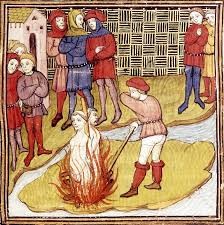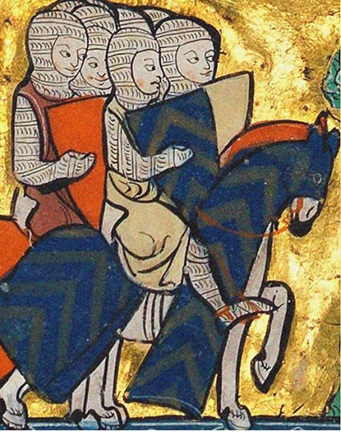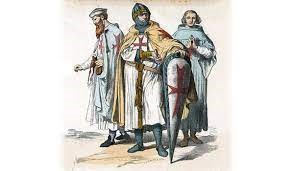The hall was packed on Wednesday 20th March for Dr. Steve Tibble’s talk on the Knights Templar.

Steve is honorary research fellow at Royal Holloway, University of London, and the author of several books on the crusader era, with two more being published in 2024/5. These will complete a trilogy of books being published by Yale, which he said were a ‘delight to write’ as we all love a good story and the Templar history is full of really cracking stories. Some of them, even some of the true ones, are so extraordinary that you couldn’t make them up.
Steve’s intention is to rehabilitate the Templars and get to the truth. He wants to convey a little of the Templars’ real achievements and show how the conspiracy theories concerning them say far more about us and our sad, modern preoccupations, than they do about this small band of extraordinarily brave medieval knights.
Steve’s talk was fascinating and was delivered with wit, humour and enthusiasm which really engaged the audience, as was evident in the large number of questions at the end.
The main content of his talk is delivered below:
STORIES: Steve started with two stories which people said at the time really happened.
Firstly, The Last Charge of the Templars
This was how they should really have ended. It was, literally, the last charge of the Templars and like the order itself, it began with bravery and ended in complete horror.
Acre 18 May 1291. 40,000 Mamluk troops broke through the outer walls. The Templar grand master, William of Beaujeu, gathered his men. They needed to seal the gap in the wall but their numbers were pitifully few. There was no army left at hand, just ten or twelve brethren and household troops. They knew there was no chance of success. They charged down the dry moat between Acre’s two sets of walls. The Mamluk assault squads lined the walls and rained death down on the crusader cavalry below. They also threw clay hand grenades full of ‘Greek fire’. This was a particularly vicious form of medieval napalm which stuck to its victims and burnt ferociously. Casualties amongst the brother knights were appalling. During one of the repeated charges, ‘a javelin came at the master of the Temple, just as he raised his left hand.’ It struck him at a critical point under the armpit and the shaft sank deep into his body. William was dragged off the field but died later that day. There were no survivors from this final, desperate garrison of Templar diehards. The brother knights had given their all – but it was not enough.
Secondly, Kiss My Calf
Less than twenty years later, a very different story was being told. Yorkshire 1310. The rector of the church of Crofton, near Wakefield, testified under oath that he had heard that a Templar had confessed to having had sex with others from the order, that he and his comrades had insulted and spat upon the crucifix. The Templar was also reported to have said that an image was shown to him of a calf placed on an altar, and he was told that he should kiss the image. John of Nassington, a knight from York testified that many brothers of the Order had assembled for a solemn feast at which they adored a certain calf and ‘adoring’ a satanic creature such as this involved kissing and licking its bottom.
These two stories appear to have little in common. British Templars and their patrons had fought and died on the battlefields of the Holy Land and yet, they had also, or so it was said, engaged in devil-worshipping rituals and bestiality. How did a small band of brave and intensely orthodox warriors become the centre of satanic cults?
From Crusaders to Conspiracies
About two thousand years ago, Jesus was born in the Roman province of Judea. The Mediterranean was European controlled and became Christian along with the rest of the Roman empire in the fourth century AD. In the 7th century, Arab and Muslim armies burst into the eastern Mediterranean. Invasions by Turkish tribes took place in the 11th century. Importantly, the majority of the population in what we call the Holy Land was still Christian. The Christian Orthodox Byzantine empire called to the West for help. In 1095 the call for volunteers for the First Crusade went out – it was extraordinarily successful and Jerusalem was recaptured in 1099.
As soon as Jerusalem was recovered, it became clear that the Crusaders were outnumbered, outmanoeuvred and out on a limb. The Templars were founded in c.1119 in Jerusalem as a hybrid military-religious order, and quickly became the nearest thing the crusader frontiers had to a standing army. In 1128, the Templar Master, Hugh of Payns, had a very productive recruitment drive in England and Scotland. British volunteers for the new warrior elite quickly rallied to the Templars’ famous piebald banner.
There were two distinct groups of ‘British Templars’. One group, the order’s British soldiers in the front-line military arm, had the ‘glamorous’ but dangerous job of fighting in its armies and manning its castle garrisons in the East. Steve said they were like the James Bonds of their day! They were supported by the less dramatic but vital work undertaken by their brothers back in Britain. In Britain the Templars were primarily diplomats and fundraisers. An important element of this was to encourage devout kings, queens and nobles to give them large numbers of estates which they could manage, improve and use to send their economic surplus out to the East. They constructed new towns, created new markets and turned woods into productive arable land. The other part of their ‘peace-mongering’ role in Britain was that of providing a superb range of medieval ‘professional services’. They were efficient lawyers, bankers and advisers to a long line of British kings and queens. Most importantly, they were embedded, and highly trusted, at the upper reaches of British governments at a time when Europe was fragmented and producing very little economic surplus. Although the crusades in the East eventually failed, they were able to defend the Christian Middle East, against all the odds, for almost two centuries.
The Templars on Trial
But the Templars, and their elegant strategy, came to an end in October 1307. On Friday the thirteenth. (This may be where the Friday 13th superstition began.) Dawn raids took place across France. The French Templars were arrested en masse. Philip IV’s troops moved in force against the order. The king’s motives are still not entirely clear. It seems that Philip was genuinely credulous about the prevalence of heresy. But he was even more genuinely in need of large amounts of cash. For the Templars, this was a dangerous combination. They were largely redundant in their role, as the crusader states had, for all practical purposes, ceased to exist and they were rich. They were accused of a series of crimes that were said to have long taken hold and corrupted the order. It was claimed that they had indulged in homosexual acts or defrauded their pious patrons. The accusations grew increasingly grave, and suspiciously shrill. The Templars had denounced Christ and regularly spat upon the cross. They had started to worship devils and idols, creating their own ‘anti-Christs’ for a new ‘anti-Christian’ religion. The shocking sins of the Templars were a huge surprise to everyone. The order’s high profile had exposed them to close scrutiny for almost 200 years, but no-one had witnessed any of this behaviour previously.
(As an answer to one of the questions, Steve explained that the French crown also accused and persecuted Lombards, Jews and Lepers in order to seize their assets. Lepers were accused of poisoning wells. It could be deduced, therefore, that the spurious accusations against the Templars were trumped up in order to seize their wealth.)
In England, as practical proof of his belief in their innocence, Edward I continued to use the services of the Templars, but at the end of the year, on 14 December 1307, Edward received a papal bull ordering their arrest. On 20 December, instructions were sent out to detain all Templars. The arrests took place on 9–11 January 1308. About 144 members of the order were rounded up and taken into custody. Unlike the brutality of the French attack on the order, the English arrests were far more informal. Within a few months, the Templar master, William de la More, was quietly released. By July 1308, he was given access to six of the Templars’ manors in order to provide an appropriately comfortable living for him and his men.
Edward never turned against the Templars. All the evidence suggests that he believed, entirely correctly, that they were innocent. His attitude suggested an expectation that the whole ghastly episode was just a dreadful mistake which might still be rectified. But it was already too late. The Master, William de la More, was arrested once more (on 28 November 1308) and orders were issued that the Templar prisoners should be guarded in a more visibly rigorous manner.
Almost a year later, in the autumn of 1309, papal inquisitors finally arrived in England. Hurried orders had to be issued to round the ‘prisoners’ up again. Accompanied by senior English clergy, papal inquisitors began to interrogate the Templar prisoners. The brothers in England were corralled together in three locations – London, York and Lincoln. Similar instructions to round up the prisoners and provide assistance to the papal inquisitors were sent to Ireland and to the English governor in Scotland.
The ‘interviews’ in Britain were based on eighty-four charges, which had been brought against the order. These ranged from relatively minor offences to more imaginative charges of idolatry and participation in satanic rituals. The interrogations were a farce. In the absence of evidence and without the use of torture there were no confessions. The prisoners testified that the order was run as a conventional religious organisation.

This was all in stark contrast to the testimonies of the French brothers, who had been tortured. There, men had been forced to confess to everything, no matter how ludicrous. One Templar priest in Albi testified that his feet had been burnt over a fire and he carried their bones in a bag.
The Templars were brave. In Paris, where torture was used, thirty-six Templar brothers died rather than make false confessions, but men would eventually say whatever they thought the inquisitors wanted to hear. Where witnesses were able to speak freely, the results of questioning were far different. In England, Ireland, Scotland and Cyprus, where the brothers were not tortured, there were almost no false confessions. With no confessions and precious little evidence, the legal process in Britain slowed down. Everyone, hoped that the problem would just go away.
The Dog Ate My Homework
In most cases it is clear that even the prosecuting authorities were unconvinced about the charges they were supposed to be pursuing. The secular authorities in England did everything they could to be unhelpful. Although they were arch rivals, not a single Hospitaller came forward to perjure themselves against the Templars. The Templars had a large number of tenants, employees and business associates, many of whom were disgruntled and who could have testified against them – but almost none did so.
William Greenfield, the archbishop of York, was very much of the ‘dog ate my homework’ school of thought when it came to excuses. He gave a series of spectacularly unconvincing reasons why he could not attend proceedings in London. He said that he could not leave York as his cross could not be carried in front of him when he left his province. At one point he claimed that he was too unwell to travel. Later, he suggested that he was too busy to leave York. And, getting his stride at this point, he finally complained that he did not receive notice of meetings until it was too late for him to set off.
The trials in Britain were turning into a farce. After several years and several hundred interrogations, the evidence against the British Templars was derisory, consisting of little more than a series of denials from the brothers, supplemented by hearsay and gossip from a relatively small number of outsiders.
One French Templar, a brother named Himbert Blanc, had been in England on a business trip on the morning of 13 October 1307, when Phillip’s men had launched their surprise attack on the order. Because he was arrested in England, he was interrogated under English law, rather than with the brutality of the French system. It is fascinating to see the very different results of the process. The brothers in France were all quickly tortured into admitting the most incredible accusations. Himbert, however, was adamant that all the charges were trumped up. He had been in the order for almost forty years and had fought in the Holy Land under William of Beaujeu. Himbert was outraged and angry rather than compliant. Throwing down the gauntlet at his accusers, he said that if anyone ‘had confessed the aforesaid errors, they had lied’.
William de la More, the Master of the British Templars was a Yorkshireman and a soldier and had been fighting in the East at a time when conditions there were dangerous in the extreme. When he was arrested in 1308, he had already served the order for almost a quarter of a century. His service to Edward I was remembered and respected by his captors. William was interrogated by some of the most senior clerics in the land, including the archbishop of Canterbury, but he steadfastly refused to make a false confession. He was sent to the Tower of London because of his obstinacy. William passed away in captivity in London on 20 December 1312. But he died of old age rather than torture. He was still firm in his beliefs and bravely protesting the innocence of the order. Death in prison was a quiet but inglorious ending for such a man.
Pope Clement was eventually persuaded that the Templars were innocent, but by then it was too late. They had little real role left and were crippled by a terminally tarnished reputation. The order was wound up. Its assets were transferred to its more adaptable rival – the Hospitallers.
Medieval Conspiracies – No Smoke without Fire
The Templars are still the subject of many modern conspiracy theories. At the time, they were accused of astonishing vices and plots. Given the number of such accusations, is it possible that they were guilty of some of them?
Calves and Cats
In one of our first stories, we encountered calf worship by the Templars. We saw that the normally specialist pleasure of kissing a calf’s anus was supposedly widespread, but only within the county of Yorkshire! In France, victims were told what to say, and then tortured until they said it. How was it possible to make such charges stick?
This is where the Yorkshire calves (literally) rear their lovely heads, and in doing so reveal not just the absurdity of the charges but also the process by which it was manufactured.
The Templars confessed to kissing a cat’s anus. This was a fabricated charge, based on the unimaginative promptings of inquisitors who had been searching through the files to find the ‘usual activities’ of heretics, but there was never any mention of calves. Cats were commonplace around medieval chapels. They were also small enough, if that was your unlikely inclination, to be conveniently introduced into satanic services.
In Yorkshire, however, they were replaced by highly incongruous and inconveniently large calves. It appears that an inexperienced clerk in Yorkshire misread the list of things that witnesses were ‘supposed’ to have seen. The Latin word for ‘cat’ (catum) was probably mistranscribed as ‘cattle’ (catellum). Armed with this prompt sheet about what they were expected to have seen, the witnesses duly obliged. The misreading of catum for catellum shows that the witnesses had been carefully primed before they gave their evidence. More specifically, it demonstrates that they had even been told what to say. The incompetence was so ridiculous that it would be funny under different circumstances, but it was also evidence of a far darker side – it shows the lengths to which the inquisitors were prepared to go to convict the British Templars.
The Secret Cult?
The most shocking accusation was that they were actually a secret satanic cult. A secret satanic cult requires, above all else secrecy, but the Templars were never an enclosed order. On the contrary, the order was well integrated within most echelons of society. Witness statements confirmed that outsiders were regularly invited into Templar houses and chapels. The brothers were happy to chat, gossip or to engage in business just like other men of their class. On the contrary, they were far more welcoming, and more inclusive, than many other monastic orders. Many non-Templars worked, and sometimes even lived, in the order’s houses, whether as servants or as secular priests. They would surely have spotted if the order had decided to focus on devil worship and idolatry rather than mainstream Christianity. There is also evidence that outsiders were occasionally even allowed to attend full chapter meetings, including sessions at the New Temple in London, and in Paris. If the brothers were trying to run a secret society, they were doing a spectacularly bad job of it.
The ‘Secrets’ of the new Temple
The New Temple had the walls, the money and the treasure boxes that have helped to create ‘the Templar legend’. And yet, their headquarters were a remarkably public place. The precinct was indeed one of the most important financial centres in Britain, but it was not just used for Templar money. It was used by the kings and bishops of England, and even by the more affluent citizens of London, as a place to store their treasure. Numerous legal documents were witnessed, signed and stored there. The church of the New Temple was also generally open to the public for prayer. These were not isolated or secretive places. There even seems to have been a thoroughfare going through the middle of the Temple precinct. The citizens of London had a right of way down to the river which was not just used by pedestrians, it was also a lane for transporting goods down to a wharf. This was hardly what one would expect at the headquarters of an ultra-secretive band of heretical sorcerers.
Guilty as Charged?
If the Templar order was innocent, then why was it suppressed? Ultimately it was redundancy, rather than guilt, that made it possible. Until torture was finally deployed in a handful of the British interrogations, there were no confessions. The obvious implication is that the charges were false and if they were false in Britain, they were probably equally spurious in other parts of the order. But after the fall of the crusader states in 1291 the Templars were left underemployed and unfocused. They had been slow to adapt to the new world order. They continued to advocate boots-on-the-ground action in the Middle East to try to liberate the Holy Land once more. But this was their only idea, and it was far too ambitious and unrealistic – no one was buying what they had to sell.
Dreams never end – Modern conspiracies
Popular culture caricatures the Templars in a variety of bizarre ways: as hoarders and treasure hunters; as irrational fanatics; as evil Assassins; as members of arcane cults and secret societies; or even (and this is the ultimate absurdity, given that they were all devout Catholics) as devil worshippers. The conspiracy theories associated with the Templars are highly tenuous at the best of times.
For example, we know that were almost no British Templar absconders or renegades. However, there are three stories about Templars in Scotland:
- That renegade Templars gathered on the west coast of Scotland
- That they enabled Robert the Bruce to win the Battle of Bannockburn
- That Rosslyn Chapel has close ‘connections’ to the Templars, and has ‘associations’ with the Holy Grail.
None of this is true. There were only two Templars in Scotland, and both of those were English! And Rosslyn was indisputably built some 140 to 180 years after the order ceased to exist.
All Our Secret Dreams
The Templar records were lost soon after the order was suppressed. Their rival, and extremely similar, military order, the Hospitallers, found a new role. They survived. But the other thing that survived was their records. And, importantly, they make monumentally dull reading. With the Templars, however, there is almost nothing left. The order’s archives have vanished. The real and probably mundane, records of the order were supplanted by the vivid imaginations of King Philip’s inquisitors. Even more depressingly, it was an inglorious and shoddy end to an order that had been an inspiration to generations of Europe’s bravest knights.
Thanks to LHS member Joy Ardy for this write up of a memorable talk!




Excellent (and very detailed) summary of a superb talk by Steve Tibble – well done, Joy!
LikeLiked by 1 person